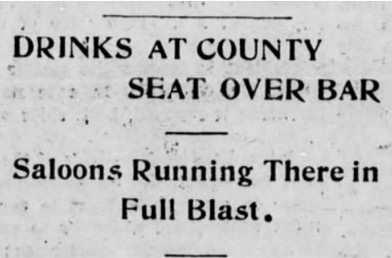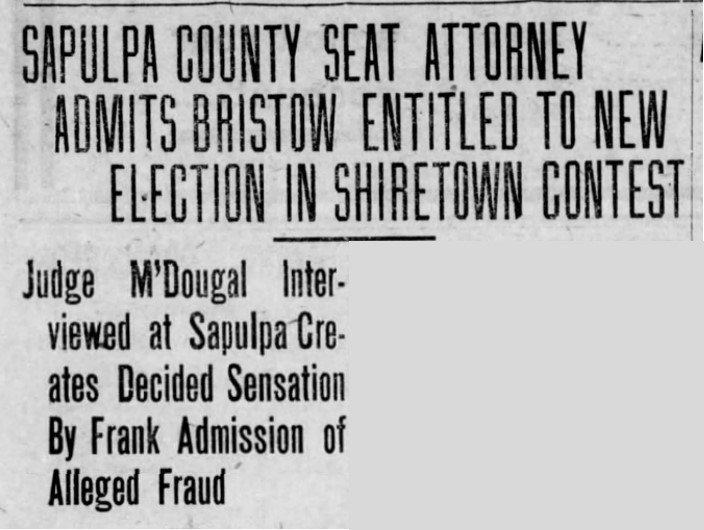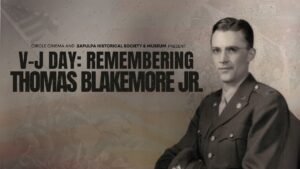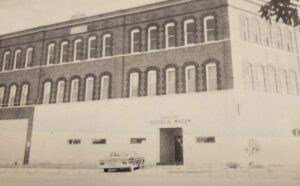Rachel Whitney, Curator,
Sapulpa Historical Museum
Oklahoma statehood was signed on November 16, 1907 as the 46th state. The Constitutional Convention had provided for the rules on how to conduct our first county and state elections. It had provided for the temporary appointment of county commissioners, clerks, and secretaries to act as election and canvassing boards.
John F. Egan and Henry H. Bogle were the county commissioners, and John H. Humphries as the clerk. They met in Bristow on August 16, 1907 and divided the county into nine townships and set up procedures for the coming election.
Until this time, there had been no counties, and people in the rural areas had not been able to vote in any previous elections for it was only set up for those residing in the cities.
Not even a full week after becoming a state, just six days later, this week in Sapulpa history, on November 22, 1907, Bristow announced their take on the county seat.
This began a feud between the cities.
In making a case for Bristow being the county seat, Bristow would from time to time try to show how Sapulpa was unfit to be the county seat. An article ran in the Bristow Record about how degenerate Sapulpa was. It stated the saloons were operating wide open in the “Capital of Creek County.”
“Drinks at County Seat Over Bar – Saloons Running There in Full Blast. Saloons at Sapulpa were running full blast, and the only difference between them and those in Oklahoma before statehood is that a small bottle of beer, retailing ordinarily for 15 cents, costs 25 cents at the Creek County Capital. The saloons did not use the ordinary precaution of getting behind screens, but operated wide-open. Stroud people will please take note. The worm has turned.”

The feud continued, gaining momentum every few months. Tulsa newspapers would report their backing Bristow as county lead. And Sapulpa papers would inturn report how “rotten” the Tulsa newspapers turned into. Tulsa and Sapulpa not only fought about the importance of their newspapers, the size of their cities, the oil industries, but now the fight over a county seat that Tulsa wasn’t even a part of.
In August 1908, a vote took place to select the county seat. The poll workers went out into the community and found everyone they could who had not voted and were eligible, and brought them to the polls.
Bristow voted entirely for Bristow. Sapulpa casted their votes for themselves. The race was won in the smaller communities who voted for Sapulpa. They were Kiefer, Mounds, and Kellyville. Bristow had Olive, Newby, Depew, and Sunny Slope. Mannford had been a virtual tie.
However, the fight was not over. It would continue for another six years.
In 1911, Judge D.A. McDougal, “attorney for Sapulpa in the county seat contest, has admitted that Bristow is entitled to a new election in the location of the capital of Creek County. In an interview with a reporter of Tulsa World, he stated when he visited Tulsa to consult attorneys about the contest. The statement of Judge McDougal created considerable of a sensation in Sapulpa, and confirmed the statements of Bristow that the first election was tainted with fraud and with irregularities that the returns were not true and correct, and that instead of Sapulpa being the winner, Bristow had won.”

Bristow petitioned. Another election. Sapulpa victorious. Bristow petitioned. Another election. Sapulpa victorious.
In June 1913, the Supreme Court ordered one last vote. Sapulpa finally won the county seat fight, officially, August 1, 1913.
However, there was another election that Sapulpa was fighting up against. This time it was on an even bigger scale.
Sapulpa had been fighting Bristow (sometimes with Tulsa) over a county seat. But Sapulpa and Tulsa fought for an election, together, over the state’s own capitol.
Also, this week in Sapulpa history, on November 25, 1910, Sapulpa and Tulsa united in their quest for the state capitol.
“At the request of Secretary Sullivan of the Tulsa Commercial Club, a committee from the local commercial club composed of R.B. Dingman, R.M. Nicholas, and B.C. Burnett, left this afternoon for Tulsa to meet a committee from Tulsa in regard to Sapulpa and Tulsa joining hands on the capitol location fight. Both Tulsa and Sapulpa are in the fight to stay and by combining forces with the idea of locating the capitol between the two, better results are sure to come.”

By combining forces the two cities believed they had a good chance at landing the capitol. They planned to locate it at Taneha or New Taneha; this was halfway between the two cities. All of northeast Oklahoma wanted the capitol in the northeast part of the state and not in Oklahoma City.* Taneha is now where the Allen-Bowden school is located and New Taneha is now called Oakhurst.
*Note: June 1910, the move of the capitol from Guthrie to Oklahoma City vote took place; however, on November 15, 1910, the Oklahoma Supreme Court voided the election. This is when Sapulpa and Tulsa put their location for capitol on the ballot. But by December 1910, the location of the capitol was back at Oklahoma City.
(Bristow Record, November 22, 1907, June 2, 1911; Sapulpa Evening Light, November 25, 1910; Tulsa World, June 11, 2023; Oklahoma Historical Society)









